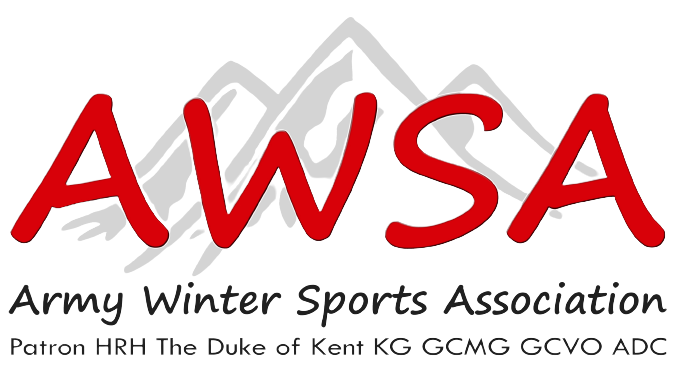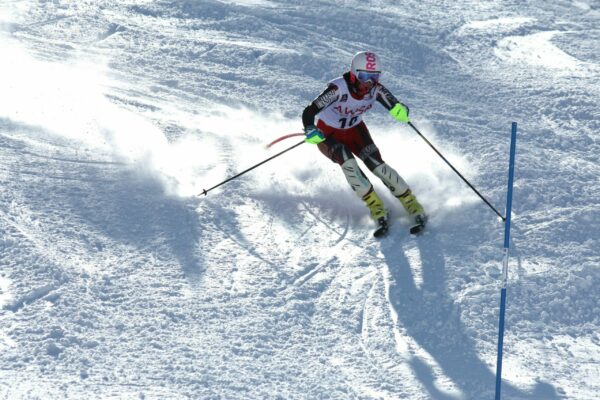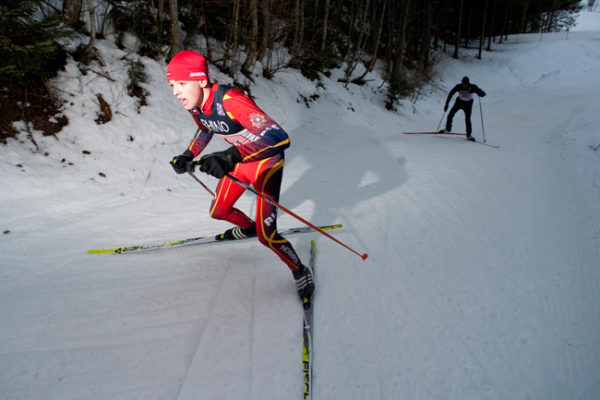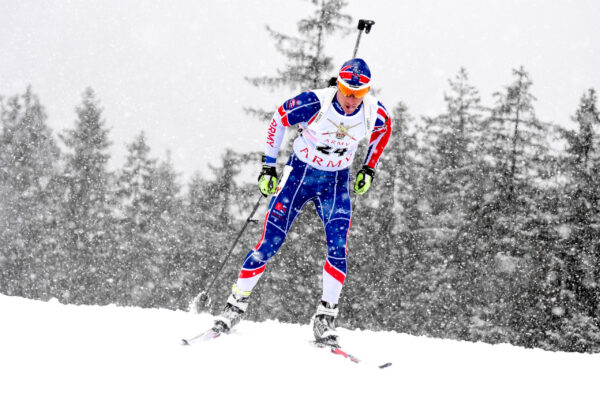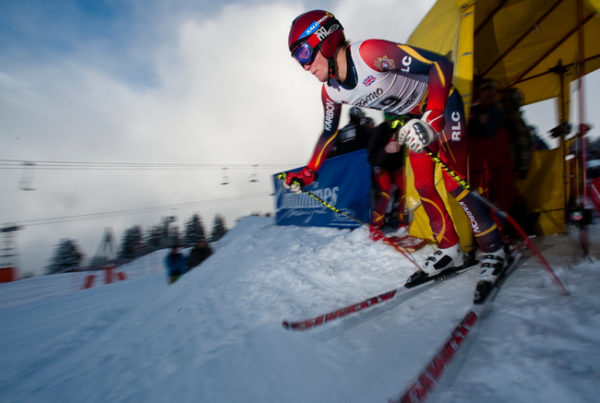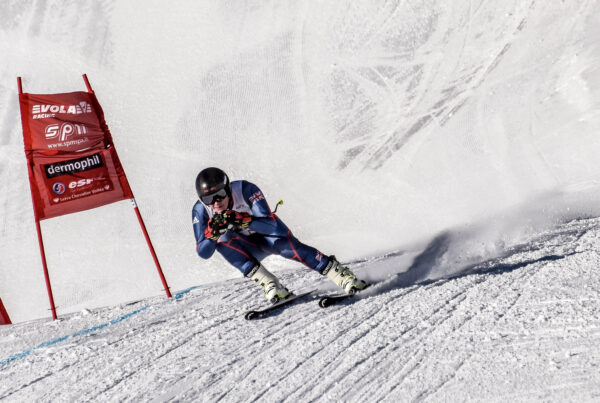What is Nordic Skiing?
- The Classic style primarily uses parallel grooves (tracks/’spor’) cut in the snow. The middle section of the bottom of the skis is prepared with a ‘kick wax’ or a manufactured texture to enable traction or gliding, dependent on the skier’s use of their body weight and strength. Ski poles (up to a maximum height) are mostly used directly forwards and backwards, supporting the direction taken by both skis. The AWSA use only this technique for the Team Championship XC ski races (Individual 15km for men, 10km for women, and Relay 4 x 5km for both) and for the Military Patrol Race. The rules are strict on which limited range of techniques may be used in Classic races.
- The Skate (or Freestyle) style developed in the 1980s, as it does not rely on getting the right ‘kick wax’ for difficult snow conditions. The ‘trail’ is prepared as a smooth, firm (hopefully) snow surface. The skier achieves propulsion by pushing their shorter skis away from one another at an angle, in a manner similar to ice skating, using the edges of the skis. This means that the whole ski bottom is prepared with glide wax to reduce friction. Longer ski poles are used in unison to enhance and support the different direction of each ski. All biathlon races use this style. In AWSA Team Championships these are the Individual Sprint (10km for men, 7.5km for women), Relay (4 x 7.5km for men, 4 x 6km for women); there are further individual races at the Army Championships only: 20km (men), 15km (novices and juniors), 12.5km (women) plus 12.5km (men) and 10km (women and juniors) mass start races.
Nordic skiing is inherently safe to learn, due to the flexible ski bindings, and is ideally suited to athletically-minded soldiers. A strong sense of balance is a definite benefit – the skis are just over 4cm wide, but light. Success in AWSA championships is also heavily dependent on rifle marksmanship techniques and skills, as every target missed incurs a race-time penalty, often through the requirement to ski additional distance on the 150m ‘penalty loop’. Each biathlon race includes prone shooting (supported by an arm sling) at 45mm circular targets and standing shooting at 110mm targets, both at 50m range.
The winter season starts with unit team training, often facilitated in corps concentrations, in November or December somewhere where snow can be guaranteed at that early stage: usually Norway or Sweden, or else in the high Alps. Teams are only allowed 30 days’ training deployment on snow prior to the AWSA Qualifying Championships, so careful scheduling is required by team captains. The Combat and Combat Support corps hold their championships as part of this training period, whilst the Service Support corps, with their far larger Army Reserve element, tend to plump for the end of the season – but these days are still included in the 30 days’ deployment allowed. On the second weekend in January the AWSA Qualifying Championships (Exs PIPEDOWN and SPARTAN HIKE) start in France for both Nordic and Alpine teams. There are four Nordic races, two XC, two biathlon and the Military Patrol Race. After 10 days the winners have been decided and those teams (male) and individual (female) who have done well enough to qualify for the Army Championships determined by comparison of performances at each Qualifying Championship. So the best 22 unit male teams and at least 25 Army women, who then compete in corps teams, travel across Europe to Ex RUCKSACK at the biathlon ‘mecca’ of Ruhpolding in southern Germany.
Summer Training
The 30 days’ training deployment on snow is sufficient to develop a new Nordic skier (a ‘Novice’, who has not been on snow on Nordic skis, military or civilian, prior to 1 Jul preceding that season) to achieve a standard to compete successfully at the AWSA Qualifying Championships, and indeed at the subsequent Army Championships. However the more time that can be spent in preparatory training the better. For the experienced nordic skier, the winter season should be the culmination of a whole year’s preparation and training.
The following training elements should be included in a Nordic skier’s year (with due acknowledgement to SSgt (Retd) Mel Pavier ex RSIGS (2005)):
- Strength – Both upper body (especially, as this is often neglected) and leg strength by either circuit training or weight training. Use plyometrics (explosive motions and short bounds). Gradually build the intensity and challenge.
- Speed – Regular sprint training on rollerskis, bikes, running etc, choice is yours, also interval training at least twice in a training cycle.
- Endurance – Long slow distance at your own optimum heart rate.
- Technique – Speed is a by-product of technique, the more efficient you are with your style the quicker you will be. Roller skiing is essential to hone the basics to optimum performance and help balance. Balance boards and balls can also be used effectively.
- Marksmanship – Obviously in biathlon the shooting is key, the summer months can be used to perfect drills and skills and concentrate on increasing accuracy and consistency. All barracks have access to a 25/30m range, so use it. Obtain your .22” rifles as early as possible. Combine with rollerskiing, but DO NOT rollerski round a course with a biathlon rifle on your back – tarmac is so less forgiving than snow – collecting and returning your rifle from a rifle rack onto your back for the shoots.
- Knowledge – Knowledge is power, there is an abundance of writing and videos on the internet waiting to be accessed, which will increase your knowledge of all aspects of the sport. It is a fine balance of so many things that will help power an athlete to victory.
Specialist Training Equipments:
- .22” Anschutz Biathlon Rifle – Obtain them as soon as they are available to be issued. If you have a particular training opportunity during the summer, ask if they can be issued early. It is far easier to learn weapon handling and marksmanship in temperate conditions rather than at -20°C (although of course you have to transition to the cold in due course). Use Barrack Non-Danger Area 25/30m ranges if the full 50m is not available – but note that correct military weapon handling drills must be used on MOD ranges. There are certified biathlon ranges at Findhorn, near Kinloss (39 Engr Regt) and RM Condor at Arbroath (contact: britishbiathlonclub@gmail.com).
- Rollerskis – Rollerskiing replicates skiing off-snow as closely as possible, preferably on smooth tarmac surfaces such as cycle tracks. Select your training location with care. An increasing range of kit is available e.g. through http://www.rollerski.co.uk/. Protective equipment, at a minimum a cycle helmet, plus eyewear if training with others, must be worn. A comprehensive Guide (based 2014) is here. There is a national rollerski series, based around the London Region Nordic Ski Club, Hyde Park Rollerski Club, Huntley Nordic Ski Club (Scotland), Wessex Biathlon & Nordic Ski Club, Cairngorm Biathlon & Nordic Ski Club and Tyneside Loipers, all of whom would welcome military members.
- Rollerblades/skates – Whilst rollerblades and rollerskates may be more available than rollerskis, and can replicate the skate style, care must be taken to keep the feet flat when pushing off – most skaters ‘push’ with the front wheel, raising their heels, a technique that is simply not possible on skis.
- Ski Simulation Machines – There are a small range of cardio machines that enable you to mimic the action of skiing in the gym, notably the Concept2 SkiErg, which units may be able to purchase through your RAPTCI. So called cross trainers exercise leg and arm muscles, but do little to replicate the correct actions.
- Dry Matting – Currently there is one purpose built dry mat for cross-country skiing, located at the Huntly Nordic and Outdoor Centre. The striding lanes, and figure of eight loop (including a little hill over a bridge) provides 400 m of track ideal for first timers looking for an introduction to classic technique to more experienced skiers who are looking for a challenging training session.
Army Colours
We list athletes awarded Army Biathlon or Cross Country Colours from 1948 – 2024.
The International records for Biathlon are believed to be 100% accurate ref Olympic Winter Games / World Cup / World Champs. There may be some omissions for IBU / European Cup or Junior events prior to 2002, International Cross Country records in the UK are somewhat vague!
For “International”, the year e.g. 2014 implies season 2013 – 2014. To view the latest list of Army Colours click here. Please email any amendments or additions to Mark Goodson at info@sportsmarkuk.com.
Governing Bodies
BRITISH BIATHLON UNION (BBU)
The BBU is the National Governing Body (NGB) for the Olympic winter sport of Biathlon in Great Britain. The BBU selects the GBR teams at all levels – the great majority of whom are historically Service personnel. The BBU website carries results and information throughout the year, but particularly details of the Membership scheme with competitor race insurance.
INTERNATIONAL BIATHLON UNION (IBU)
The IBU is the International Governing Body (IGB) for Biathlon. Related sport forms are roller skiing and shooting (= Summer Biathlon), cross-country running and shooting (= Cross Biathlon), mountain biking and shooting (= Mountain Bike Biathlon). The IBU website is primarily a media hub, but has links and detailed information on all aspects of Biathlon, including the Calendar of events and Results, Live Broadcasting of races and the full Competition Rules.
SNOWSPORT ENGLAND (SE) and SCOTLAND (SS)
SE and SS are the NGBs for snowsport in England and Scotland respectively, and focus on inspiring participation at every level, as well as developing athletes. They provide oversight of club activities, including rollerskiing, and SS has a more developed focus on XC. Both provide instructor awards, which are not easy to find through their main websites, so are here: SE and SS. SS has a better XC webpage with advice.
GB SNOWSPORT (GBS)
GBS is the NGB responsible for FIS disciplines, including Parasnowsports, in the UK, managing elite British teams and the development pathway for those athletes. It licences UK competitors to participate in international competitions, where required. The British Nordic website provides a better focus on the elite and developing XC skiers.
BRITISH ASSOCIATION OF SKI INSTRUCTORS (BASI)
BASI is a UK based membership association responsible for the training and licensing of snowsport instructors and coaches. It aims to deliver professional qualifications in instruction and coaching for those working within snowsports. It is therefore a comprehensive, albeit expensive, option for those wishing to obtain and maintain accredited qualifications. The Nordic Qualification Pathway is here.
INTERNATIONAL SKI FEDERATION (FIS)
FIS is the IGB for many skiing disciplines including XC. The FIS XC website has links and detailed information on all aspects of XC, including the full Competition Rules.
